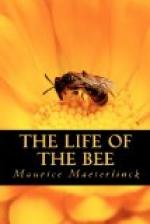In fact you will find, if you make this experiment yourself, that communication, if not general, at least is frequent. The possession of this faculty is so well known to American bee-hunters that they trade upon it when engaged in searching for nests. Mr. Josiah Emery remarks on this head (quoted by Romanes in his “Intellect of Animals “): “Going to a field or wood at a distance from tame bees with their box of honey, they gather up from the flowers and imprison one or more bees, and after they have become sufficiently gorged, let them out to return to their home with their easily gotten load. Waiting patiently a longer or shorter time, according to the distance of the bee-tree, the hunter scarcely ever fails to see the bee or bees return accompanied by other bees, which are in like manner imprisoned till they in turn are filled; then one or more are let out at places distant from each other, and the direction in which the bee flies noted; and thus, by a kind of triangulation, the position of the bee-tree proximately ascertained.”
[47]
You will notice too in your experiments that the friends who appear to obey the behests of good fortune do not always fly together, and that there will often be an interval of several seconds between the different arrivals. As regards these communications, therefore, we must ask ourselves the question that Sir John Lubbock has solved as far as the ants are concerned.
Do the comrades who flock to the treasure only follow the bee that first made the discovery, or have they been sent on by her, and do they find it through following her indications, her description of the place where it lies? Between these two hypotheses, that refer directly to the extent and working of the bee’s intellect, there is obviously an enormous difference. The English savant has succeeded, by means of an elaborate and ingenious arrangement of gangways, corridors, moats full of water, and flying bridges, in establishing that the ants in such cases do no more than follow in the track of the pioneering insect. With ants, that can be made to pass where one will, such experiments are possible; but for the bee, whose wings throw every avenue open, some other expedient must of necessity be contrived. I imagined the following, which, though it gave no definite result, might yet, under more favourable conditions, and if organised more carefully, give rise to definite and satisfactory conclusions.
My study in the country is on the first floor, above a somewhat lofty room; sufficiently high, therefore, to be out of the ordinary range of the bees’ flight, except at times when the chestnuts and lime trees are in bloom. And for more than a week before I started this experiment I had kept on my table an open comb of honey, without the perfume having attracted, or induced the visit of, a single bee. Then I went to a glass hive that was close to the house, took an Italian bee, brought her to my study, set her on the comb, and marked her while she was feeding.




